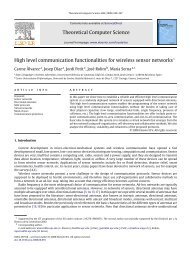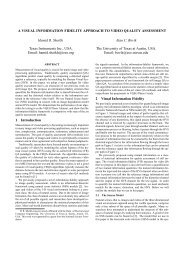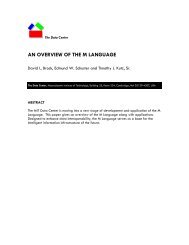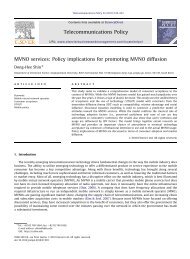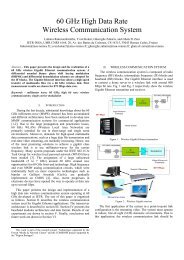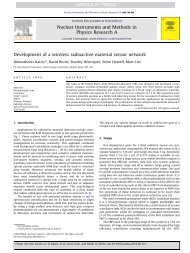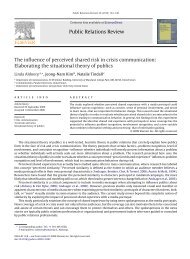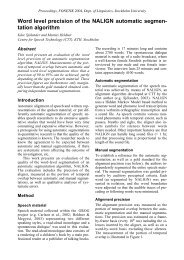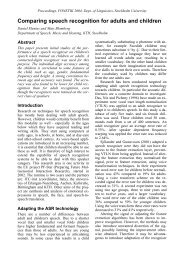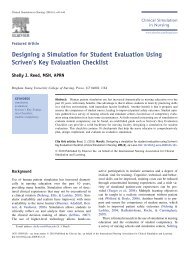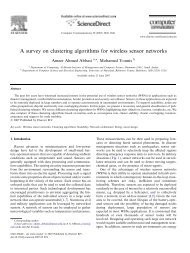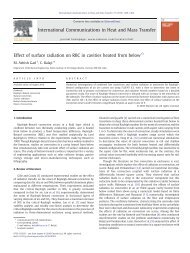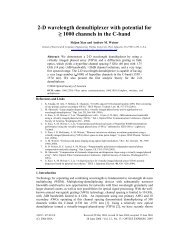Offline handwritten Arabic cursive text recognition using Hidden ...
Offline handwritten Arabic cursive text recognition using Hidden ...
Offline handwritten Arabic cursive text recognition using Hidden ...
Create successful ePaper yourself
Turn your PDF publications into a flip-book with our unique Google optimized e-Paper software.
Table 1<br />
<strong>Arabic</strong> letter shapes.<br />
zones of equal height. Using the same training and testing conditions<br />
with the IFN/ENIT v1.0p2, the <strong>recognition</strong> rate achieved<br />
was 89.1% for top 1 and 96.4% for top 10 candidates. In (El-Hajj<br />
et al., 2005), HMM was also applied to word <strong>recognition</strong>, <strong>using</strong><br />
24 statistical features like foreground pixel density and concavity<br />
extracted from divided word image along with 15 baseline independent<br />
features. Through modeling each character with a left to<br />
right topology, their HMM classifier had four states for each character<br />
model resulting 159 character models in total. Again <strong>using</strong><br />
the IFN/ENIT database v1.0p2 for training and set d for testing,<br />
their system had a <strong>recognition</strong> rate of 75.41%.<br />
Al-Hajj et al. (2007) presented a two stage system for recognizing<br />
<strong>handwritten</strong> <strong>Arabic</strong> words. In the first stage, three HMM classifiers<br />
were applied with pixel-based features to determine the best<br />
ten candidates (top 10) <strong>using</strong> likelihood. In the second stage, results<br />
from these classifiers were fused for a combined decision<br />
via three schemes, including the sum rule, the majority vote rule,<br />
and neural network based fusion. Using the IFN/ENIT benchmark<br />
database, the <strong>recognition</strong> rate achieved was 90.96%. These three<br />
schemes were also used in (Al-Hajj et al., 2009) to combine three<br />
homogeneous HMM classifiers for improved performance. The <strong>recognition</strong><br />
rate achieved on IFN/ENIT v1.0p2 was 90.26% for top 1,<br />
94.71 for top 2, and 95.68% for top 3.<br />
4. Proposed techniques and system implementation<br />
In this paper, we proposed an off-line <strong>recognition</strong> system for the<br />
<strong>handwritten</strong> <strong>Arabic</strong> <strong>cursive</strong> <strong>using</strong> HMM and re-ranking. The whole<br />
system contains three stages in terms of preprocessing, feature<br />
extraction, and classification in the following sections. The block<br />
diagram of the proposed <strong>handwritten</strong> <strong>Arabic</strong> <strong>cursive</strong> <strong>text</strong> recogni-<br />
J.H AlKhateeb et al. / Pattern Recognition Letters 32 (2011) 1081–1088 1083<br />
Training<br />
samples<br />
Recognized<br />
results<br />
Testing<br />
samples<br />
tion system is shown in Fig. 1. As shown in Fig. 1, once a sample<br />
image is acquired, pre-processing is required to standardize the<br />
signal for better performance in the following stages. Afterwards,<br />
features are extracted and fed to a HMM classifier for classification.<br />
The results of the HMM is further refined by <strong>using</strong> a re-ranking<br />
scheme for improved accuracy. Relevant techniques are discussed<br />
in details as follows.<br />
4.1. Preprocessing<br />
Pre-processing<br />
Reranking<br />
Pre-processing<br />
Feature<br />
Extraction<br />
HMM<br />
classifier<br />
Feature<br />
Extraction<br />
Fig. 1. The proposed scheme for word <strong>recognition</strong>.<br />
Feature<br />
database<br />
The main aim of preprocessing is to enhance the inputted signal<br />
and to represent it in a way which can be measured consistently<br />
for robust <strong>recognition</strong>. Here preprocessing stage involves scanning<br />
the paper document, removing noise, image enhancement, and<br />
segmentation, which are strongly dependent on the quality of<br />
the paper document. As a result, pre-processing includes many relevant<br />
techniques such as thresholding, skew/slant correction, noise



